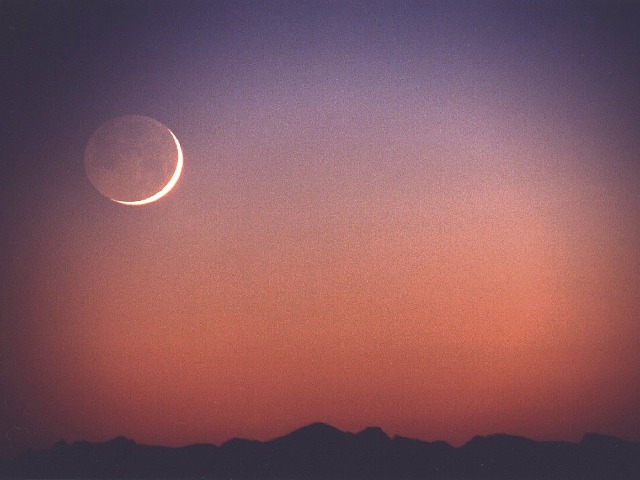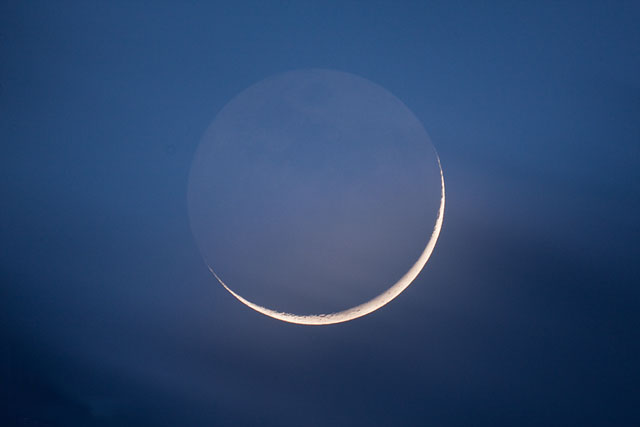 The Biblical month begins with the crescent New Moon, also called First Visible Sliver. The Hebrew word for month is (Hodesh) literally means New Moon and only by extension the period between one New Moon and the next. "Hodesh" (New Moon), is derived from the root Chadash . meaning "new" or "to make new/ renew". The Crescent New Moon is called Hodesh because it is the first time the moon is seen anew after being concealed for 1-1.5 days at the end of the lunar cycle. At the end of the lunar month, the moon is close to the sun and eventually reaches the point of "conjunction" (when it passes between the Sun and the Earth). As a result, around the time of conjunction very little of the moon's illuminated surface faces the Earth and it is not visible through the infinitely brighter glare of the sun. After the moon moves past the sun it continues towards the opposite side of the Earth. As it gets farther away from the sun, the percentage of its illuminated surface facing the Earth increases and one evening shortly after sunset, the moon is seen anew after being invisible for 1-2 days. Because the moon is seen anew after a period of invisibility the ancients called it a "New Moon" or "Hodesh" (from Hadash meaning "new").
The Biblical month begins with the crescent New Moon, also called First Visible Sliver. The Hebrew word for month is (Hodesh) literally means New Moon and only by extension the period between one New Moon and the next. "Hodesh" (New Moon), is derived from the root Chadash . meaning "new" or "to make new/ renew". The Crescent New Moon is called Hodesh because it is the first time the moon is seen anew after being concealed for 1-1.5 days at the end of the lunar cycle. At the end of the lunar month, the moon is close to the sun and eventually reaches the point of "conjunction" (when it passes between the Sun and the Earth). As a result, around the time of conjunction very little of the moon's illuminated surface faces the Earth and it is not visible through the infinitely brighter glare of the sun. After the moon moves past the sun it continues towards the opposite side of the Earth. As it gets farther away from the sun, the percentage of its illuminated surface facing the Earth increases and one evening shortly after sunset, the moon is seen anew after being invisible for 1-2 days. Because the moon is seen anew after a period of invisibility the ancients called it a "New Moon" or "Hodesh" (from Hadash meaning "new").Many people have been led astray by the inaccurate use in modern languages of the term "New Moon". Modern astronomers adopted this otherwise unused term, which had always referred to the first visible sliver, and used it to refer to when the Moon passes between the Earth and the Sun, at which time it is not visible. The astronomers soon realized that the inaccurate use of "New Moon" to refer to conjunction would lead to confusion, so to be more accurate, scientists now distinguish between "Astronomical New Moon" and "Crescent New Moon". "Astronomical New Moon" means New Moon as the term is used by astronomers, i.e. conjunction. In contrast, "Crescent New Moon" uses the term in the original meaning of the first visible sliver. A good English dictionary should reflect both meanings. For example, the Random House Dictionary of the English Language, Unabridged Edition defines New Moon as: "The moon either when in conjunction with the sun or soon after being either invisible [Astronomical New Moon] or visible [Crescent New Moon] only as a slender crescent." I summit to you that the ancient Hebrews knew that Hodesh was the sighting of the Crescent New Moon.
It is a point to consider that there is no actual "day" of concealed moon. In fact the moon stays concealed anywhere from 1-2 days in the Middle East. It has been proposed that the "day" of concealed moon is actually the day of conjunction (when the moon passes between the Earth and Sun). However, it was only 1000 years after Moses that the Babylonian astronomers discovered how to calculate the moment of conjunction. Therefore, the ancient Israelites would have had no way of knowing when the moment of conjunction takes place and would not have known on which day to observe "Concealed Moon Day".
It has been suggested that the ancient Israelites could have looked at the "Old Moon" and determined the Day of Conjunction by when the Old Moon was no longer visible in the morning sky. However, such a method would not work in the Middle East where the so-called "concealed moon" can remain concealed for as many as 1-2 days! It is in fact common for the moon to stay concealed for 2 days and in such instances how would the ancient Israelites have known which day was the Day of Conjunction?
In contrast, the ancient Israelites would have been well aware of the Crescent New Moon. In ancient societies people worked from dawn to dusk and they would have noticed the Old Moon getting smaller and smaller in the morning sky. When the morning moon had disappeared the ancient Israelites would have anxiously awaited its reappearance 1-2 days later in the evening sky. Having disappeared for several days and then appearing anew in the early evening sky they would have called it the "New Moon" or "Hodesh" (from Hadash meaning "New").
New Moon
New Moon – According to scripture
According to the ancient writing
 s (Bible), New Moon is considering not only the beginning of the month, but also in ancient Israel it was considered a holy day (special day). The following scriptures will give clear indication that New Moon was commemorated in ancient Israel. (1 Samuel 20:4,5, 1 Samuel 20:18, 1 Samuel 20:24, 2 Chronicles 2:4,
s (Bible), New Moon is considering not only the beginning of the month, but also in ancient Israel it was considered a holy day (special day). The following scriptures will give clear indication that New Moon was commemorated in ancient Israel. (1 Samuel 20:4,5, 1 Samuel 20:18, 1 Samuel 20:24, 2 Chronicles 2:4, 2 Chronicles 31:3, Ezekiel 46:1-3, Colossians 2:16) As being that the New moon was considered a holy day in ancient Israel, it still remains a holy day in our present time, as it will remain a holy day in the new kingdom. - Isaiah 66:23.
The Most High, the creator of the universe is unchanging and he changes not. – Malachi 3:6
New Moon is also day of no work / labor that should not be performed (i.e. commerce). - Amos 8:5
New Moon upon the Hebrew calendar is a neutral day, a day that is not be counted as a working day. In Amos 8:5 gives clear indication that it’s not a day for work / labor (i.e. commerce). According to this following scripture:
Ezekiel 46:1-3
1. Thus saith the Lord GOD; The gate of the inner court that looketh toward the east shall be shut the six
working days; but on the sabbath it shall be opened, and in the day of the new moon it shall be opened.
2. And the prince shall enter by the way of the porch of that gate without, and shall stand by the post of
the gate, and the priests shall prepare his burnt offering and his peace offerings, and he shall worship at
the threshold of the gate: then he shall go forth; but the gate shall not be shut until the evening.
3. Likewise the people of the land shall worship at the door of this gate before the Lord in the sabbaths
and in the new moons.
In relation to Ezekiel 46:1-3, according to the holy scriptures (Bible), there is 7 days per week upon the Hebrew calendar that was observed by the biblical Israelites. As per these below scriptures, there are 6 working days and on the 7th day is a Sabbath.
(Exodus 20:8-11, Exodus 23:12, Exodus 31:15, Exodus 34:21, Exodus 35:2, Leviticus 23:3, Deuteronomy 5:13-14)
Sabbath = Holy day, a day of rest and also a day of no work / labor - (i.e. commerce)
New Moon = Holy day, a day of no work / labor – (i.e. commerce). As explained in the above, New moon is not part part of the 7th day weekly cycle, as it’s not one of the 6 working days. New moon day or Day of the new moon is only
the beginning of the month, a day that is not be counted as a work day, but only a day that is considered as
the (first day of the month).
Scriptural references regarding New moon and the beginning of the month
Is the Rabbinical Molad/Lunar Conjunction New Moon?
The Signal
 The Sabbath law was given a few months after the exodus. Upon Yah (God) introducing the 10 commandments (including Sabbath law) to the Israelites, we have to keep in mind that during the exodus period which was around 1491 B.C. none of the solar calendars from Rome were in existence. The only way the biblical Israelites kept the Sabbath law in the dessert for 40 years is by observing the moon as per Genesis 1:14. The weekly cycles upon the Hebrew lunar calendar and the solar calendars from Rome are not identical, nor do they line up evenly.
The Sabbath law was given a few months after the exodus. Upon Yah (God) introducing the 10 commandments (including Sabbath law) to the Israelites, we have to keep in mind that during the exodus period which was around 1491 B.C. none of the solar calendars from Rome were in existence. The only way the biblical Israelites kept the Sabbath law in the dessert for 40 years is by observing the moon as per Genesis 1:14. The weekly cycles upon the Hebrew lunar calendar and the solar calendars from Rome are not identical, nor do they line up evenly. In order to properly identify the new moon, we would have to pretend of living during the exodus period and of course living in the dessert for 40 years, would mean that you are without electricity and all the means of modern technology that we have available today. During the 40 year dessert occupation, the biblical Israelites were relying on several things, such as their senses and the main one that was primarily used was “sight” and of course proper guidance from the Most High, along with his assistance of feeding them manna. According to Genesis 1:14, Yah (God) created both sun and moon for signs, for seasons, for days, and for years. During the 40 year dessert occupation, the biblical Israelites needed a signal to confirm the beginning of the month and confirming the beginning of the month, they needed to use sight, as in looking into the night sky to confirm.
Many today are confused on implying that a dark moon is the new moon, however this modern practice of confirming a dark new moon is not scriptural, nor was a dark moon ever confirmed as the beginning of the month through the ancients. One cannot confirm the beginning of the month by seeing a dark moon with the naked eye, which overall cannot be seened at all in the night sky. A dark moon is not a signal to provide confirmation; the same applies on verifying a full moon as the beginning of the month. A full moon according to the lunar phases to the human eye is visually full from 2-3 days and 4,000 years ago the biblical Israelites did not have modern technology, that we have today to confirm the exact percentage of a full moon and confirming a full moon with the naked eye, will leave room for errors on calculating the 7th day Sabbath.
There is also the belief of reckoning if full moon is actually the sign of a new month, as there are several variables that bare witness to the viable conclusion of Khodesh. The Biblical Calendar of the Most High is one that begins with a New Moon signal, but is this signal a Full Moon? Scripture, Historical Data, other Biblical Writings and the testimony of the witnesses allow us to conclude upon sound reasoning as to what A Full Moon is, how its observed and what elements it Consist of. Is the Theory of Full Moon being NEW truth or is it yet another one of MANY doctrines based on Mans Reasoning? A literal explanation if New moon a full moon can be viewed here
Yah would give his people simple instructions to follow as he is not the author of confusion.
According to the following scriptures:
Psalm 104:19
He appointed the moon for seasons: the sun knoweth his going down.
Seasons in Hebrew is mowed, which means an appointment, (i.e. a fixed time)
Jeremiah 31:35
Thus saith the Lord, which giveth the sun for a light by day, and the ordinances of the moon and of the stars for a light by night, which divideth the sea when the waves thereof roar; The Lord of hosts is his name.
Ordinances in Hebrew is chuqqah which means something prescribed, enactment, usually with reference to matters of ritual.

As we would continue with following scriptures in regards to confirming the New moon signal.
Psalm 81:3
Blow up the trumpet in the new moon, in the time appointed, on our solemn feast day.
Numbers 10:10
Also in the day of your gladness, and in your solemn days, and in the beginnings of your months, ye shall blow with the trumpets over your burnt offerings, and over the sacrifices of your peace offerings; that they may be to you for a memorial before your God: I am the Lord your God.
Ecclesiasticus 43:6 (Apocrypha)
He made the moon also to serve in her season for a declaration of times, and a sign of the world.
In plain english, the moon was made as a watch in the sky. So in order to know the time. we would presume that you will have to look at your watch?
According to Ecclesiasticus 43:6, it says "sign of the world" and the Hebrew word for sign is "oth" which means from the Hebrew strong concordance. (in the sense of appearing); a signal (literally or figuratively), as a flag or beacon.
The word sign is an acronym for the word signal and the word signal would most likely be something that is of hearing or visual confirmation. New crescent moon is a sign or a signal which can be visually confirmed in the evening.